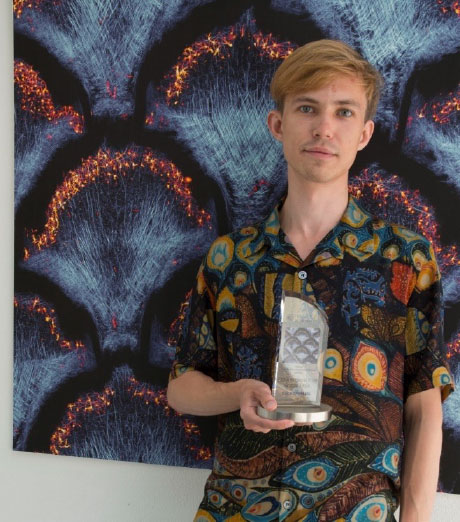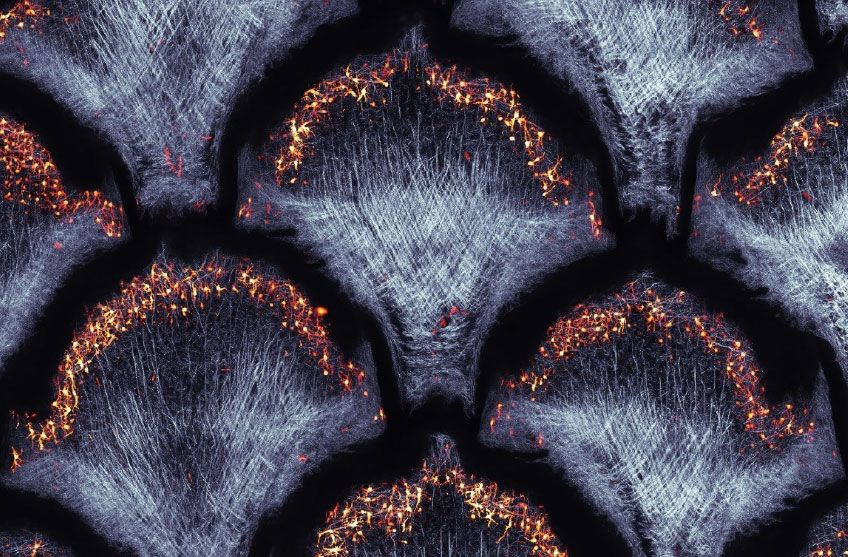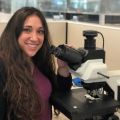In March, we announced the winners of Olympus’ Global Image of the Year (IOTY) contest for 2020. Like past years, the submissions were exemplary. We and the judges are amazed at the stunning microscopic works of art that these scientists produce, which makes choosing the winners that much harder. Luckily, as IOTY is a global imaging contest, we have three regional prizes in addition to the global award.

For Europe, the Middle East, and Africa (EMEA), the 2020 winner was Grigorii Timin from Geneva, Switzerland. His image is of collagen fibers, pigment cells, and red blood cells in the dermal layer of scales in an African house snake embryo. Grigorii explains that the “optical section is going parallel to skin surface on the depth where scales begin. That’s why regions of scales containing pigment cells are not scale tips, but oppositely scale bases.”
Download the original JPEG (4.31 MB) of Grigorii’s image here.
If you’re curious about Grigorii’s background and what led him to capture his prize-winning image, read our interview with the researcher below.
Q: Where and when did you first learn to use a microscope? Do you have a scientific background?
A: When I was twelve my school biology teacher gave me a microscope to use at home so that at any time I could practice histology and plant anatomy and have some fun observing protists and microscopic worms. It was a heavy German machine, built before the Second World War, with wonderful optics and this kind of old-fashioned design that made you feel like a scientist just by having this microscope on your table.
Today, I’m a PhD student at the University of Geneva. Under the supervision of Prof. Michel Milinkovitch, I’m working on the development and evolution of skin appendages and skin color patterns in reptiles. I’m happy that it requires a lot of microscopy.
Q: How did you become inspired to use microscopes to create art?
A: My imaging data serves scientific purposes first of all. When facing the beauty of microworld organization, I’m thinking about how to highlight it, how to make it visible and clear. An artistic part of the working process appears just naturally due to visual associations, allusions, and a feeling of harmony.
Q: How did you capture your image? What do you personally find exciting about the image?
A: I performed nonlinear optical imaging of a cleared whole-mount sample of embryonic skin using a confocal microscope with a 63X oil immersion objective lens. When excited at the 860 nm wavelength, emission signal was detected in two channels: second harmonic generation signal of collagen fibers at 430 nm and two-photon excitation fluorescence of dermal pigment cells at 550–700 nm.
For me, this image is attractive for being simple (on a large-scale view we see only scales, while on small-scale view we see only collagen fibers, pigment cells, and a bit of red blood cells—these objects differ not only in shape, but also in color, and there are no objects of middle-size that would be out of these two spatial scales) and repetitive (on both large-scale and small-scale views there are patterns). At the same time, the image is technically sophisticated.
Thinking of Submitting Your Image to IOTY 2021?
If you are a microscopist with an artistic eye like Grigorii, consider submitting your best images (up to 3) to our 2021 contest, which will be announced soon. We hope his image and story inspire and encourage you to capture your own art under the microscope.
Related Content
Scientific Works of Art: Announcing the Winners of Our 2020 Global IOTY Award
Body Part Art: Our Most Popular Microscope Images for July 2021
Embracing Social Media and Its Important Role in Science Outreach

